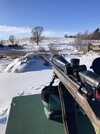Palladan44
Member
- Joined
- Nov 7, 2020
- Messages
- 1,904
My BLL has risen once again to an elevated level, above 10, which my doctor said was too much and I needed to mitigate my exposures. Is 10 bad? No, not really. But it's 3-4x more than the normal for an adult.
Shooting indoors exposes the lungs and skin to aerosoled lead dust from primers as well as bullets smashing into the trap.
I'm thinking this is the main culprit, so I plan to discontinue shooting indoors weekly to only once per month.
But I plan to handload just the same. I wonder all that spent primer dust gets aerosoled in the air when depriming as well as dry tumbling I plan to cut back on, gonna get into wet tumbling as soon as I can. I use more coated and or plated/jacketed bullets these days, no more dark grey fingertips after a session these days.
But generally speaking, round for round let's say you handload 1000 rounds. Then you shoot 500 of them indoors and 500 of them outdoors. Which exposes you the most to lead. The loading process (all steps) or shooting?
Shooting indoors exposes the lungs and skin to aerosoled lead dust from primers as well as bullets smashing into the trap.
I'm thinking this is the main culprit, so I plan to discontinue shooting indoors weekly to only once per month.
But I plan to handload just the same. I wonder all that spent primer dust gets aerosoled in the air when depriming as well as dry tumbling I plan to cut back on, gonna get into wet tumbling as soon as I can. I use more coated and or plated/jacketed bullets these days, no more dark grey fingertips after a session these days.
But generally speaking, round for round let's say you handload 1000 rounds. Then you shoot 500 of them indoors and 500 of them outdoors. Which exposes you the most to lead. The loading process (all steps) or shooting?


